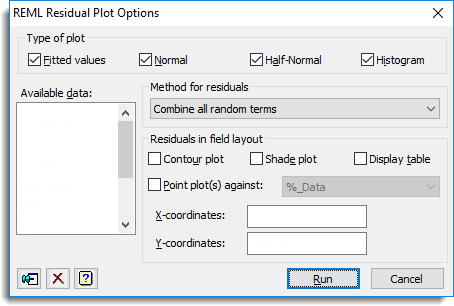The check boxes in this menu allow you to select various types of plot of residuals from a REML analysis:
| Fitted values | Residuals versus fitted values |
| Normal | Normal plot |
| Half-Normal | Half-Normal plot |
| Histogram | Histogram of residuals |

Available data
This lists variates that can be used for the coordinates for locations. Double-click on a variate name to copy it to the field which currently has focus.
Method for residuals
The list allows selection from type of residuals that can be used.
| Combine all random terms | Use the residuals combined from all random terms. |
| Final random term only | Use the residuals from the final random term. |
| Standardized residuals from all random terms | Uses standardized residuals after combining them from all random terms. |
| Standardized residuals from final random term only | Uses standardized residuals from the final random term. |
| Combine all random terms, excluding spline terms | Use the residuals combined from all random terms except spline terms. |
Residuals in field layout
In a field experiment it can be useful to study the spatial pattern of the residuals, for example to see if there are any systematic trends in fertility. These options allow you to plot the residuals in field layout.
Contour plot
When selected a contour plot of the residuals will be drawn if the plots are on a regular grid.
Shade plot
When selected a shade plot of the residuals will be drawn if the plots are on a regular grid.
Display table
When selected, displays the residuals in a table whose structure corresponds to the field layout.
Point plot
When selected, displays the residuals in point plots. The dropdown list box selects whether to give a plot against the X coordinates, or a plot against the Y coordinates, or to provide plots against both X and Y coordinates.
X-coordinates
A variate specifying the X-coordinates for the locations of the plots.
Y-coordinates
A variate specifying the Y-coordinates for the locations of the plots.
See also
- VPLOT procedure for plotting residuals
- VFRESIDUALS procedure to calculate standardized residuals
- VDFIELDRESIDUALS procedure to residuals in field layout